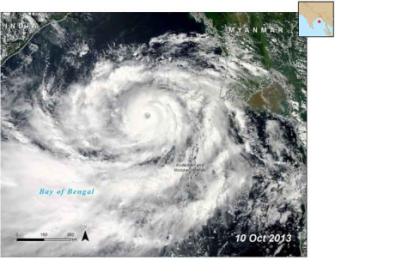In mid-October, effective disaster planning, government cooperation, preparedness at the community level and early warning communication contributed to a minimal death toll in the wake of the strongest cyclone to hit India in 14 years, Cyclone Phailin. Early warning alerts, disseminated four days before Phailin struck land in October 12, 2013 led to the evacuation of nearly 1.2 million people and the relocation of more than 30,000 animals.
Ultimately, a total of 21 lives were lost as a result of the cyclone and an additional 23 lives due to the severe flash flooding. Moreover the impacts of Cyclone Phailin and ensuing floods also affected more than 13.2 million people and caused hundreds of millions of dollars in damage to homes, schools, crops and the fishing industry. However, this aftermath resulted in a much lower death toll than a catastrophic cyclone of similar strength that struck India in 1999, Cyclone 05B, which had a much more devastating outcome: more than 10,000 lives were lost. In response, preparedness and early warning communications and activities had been much improved since the comparable Cyclone 05B
Continued early warning efforts could have similar positive results in the future and be applied to other disasters such as the recent Typhoon Haiyan. This event demonstrates the effectiveness of early warning actions, effective preparation activities and impact mitigation and the crucial role they play for saving lives during a massive disaster.

